Final Torra Bay Update & Summary Conclusions
Sunday 5 February 2023
When the “Torra” lioness Xpl-108 returned to the Torra Bay Holiday area on 23 January 2023, she remained in the Uniab Delta area until the end of January. Here movements varied between: a) visits to the beaches at night to capture mainly juvenile seals or pups that were born between December and January and b) active hunting for terrestrial mammals, such as gemsbok, springbok & ostriches.
During the last week there was only one incident when an angler drove off-road towards the lioness and caused significant disturbance. Unbeknownst to the angler, pulling a trailer behind his 4x4 vehicle, his arrival spoiled a golden opportunity for the lioness to capture a gemsbok. Xpl-108 spotted a herd of gemsbok grazing at spring from a distance of 3.2 km and after painstakingly stalking them for 7 hours, she was downwind and within 35 metres of her quarry (the best chance of success she's had in weeks). Perhaps not seeing the lion or the gemsbok, the vehicle drove in between the lioness and her prey and the gemsbok moved away. It was also a disappointment for the tourists that have patiently been observing the hunt from the main road.
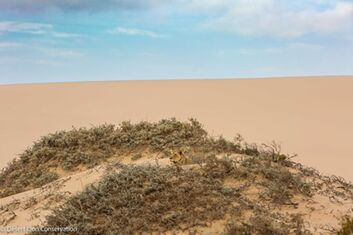
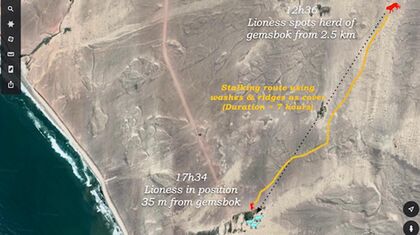
Xpl-108 spotted a herd of gemsbok from a hummock.
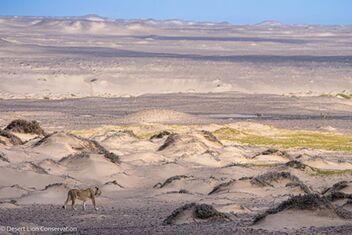
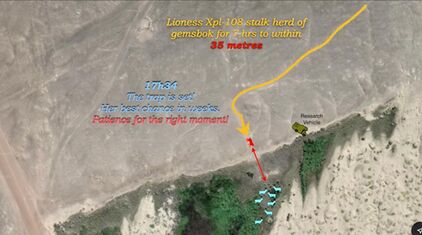
Lioness stalking a herd of gemsbok for 7 hours.
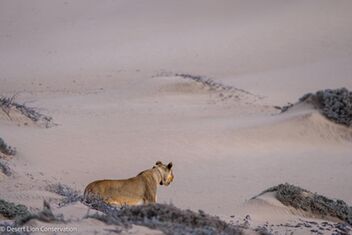
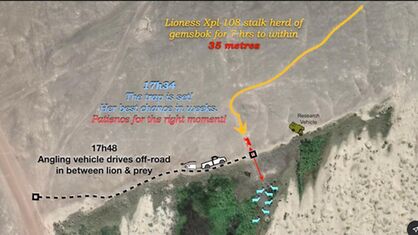
Lioness Xpl-108 within 35 metres of her prey when tourist vehicle spoiled her chances. Photos.
An evaluation of the movements of a Coastal lioness and her interactions with anglers / visitors during the 2022/3 Torra Bay Holiday Period.
The Ministry of Environment, Forestry & Tourism (MEFT) and DLCT collaborated during the two-month period (December - January) to monitor the movements and behaviour of the lioness Xpl-108 and to address and prevent any potential incidents of conflict.
The activities of the lioness Xpl-108 were documented in detail during 24-hour cycles for 70 days: from 19 Nov 2022 to 28 January 2023.
During the two-month period the lioness spent 34 days inside the Torra Bay Holiday Area as indicated by her movements and daily resting sites (Figures 1a. b & c). Apart from five days in the southern section (Figure 1a), near the Koigab seal colony, the lioness spent most of her time (N = 29 days) between Torra Bay and the mouth of the Uniab River, during two visits to the coastal habitat (Figure 1b, N=20 days & Figure 1c, N=9 days).
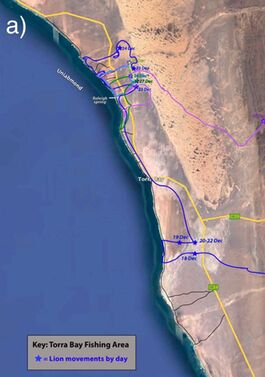
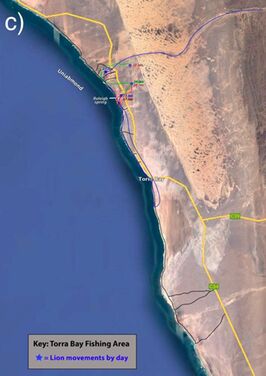
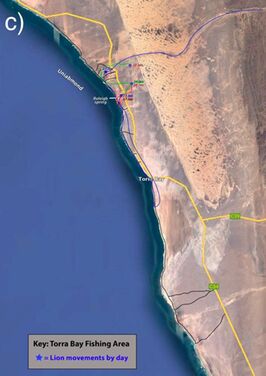
Figure 1.
Daily movements of lioness Xpl-108 in the Torra Bay fishing area during: (a) December 2002, (b) early-mid January, and (c) late January 2023.
Behaviour ecology of the “Torra” lioness Xpl-108
Data on the activities of the lioness were divided into seven 10-day periods to illustrate variations in her movements and behaviour in relation to tourism and angling activities at Torra Bay. For the two-month period combined, starting one week prior to the opening of Torra Bay, the lioness moved over a home-range area of 5,905 km2 (Figure 2). She walked at total distance of 742 km at an average of 11.1 km/day (range: 0.2 – 43.3 km).
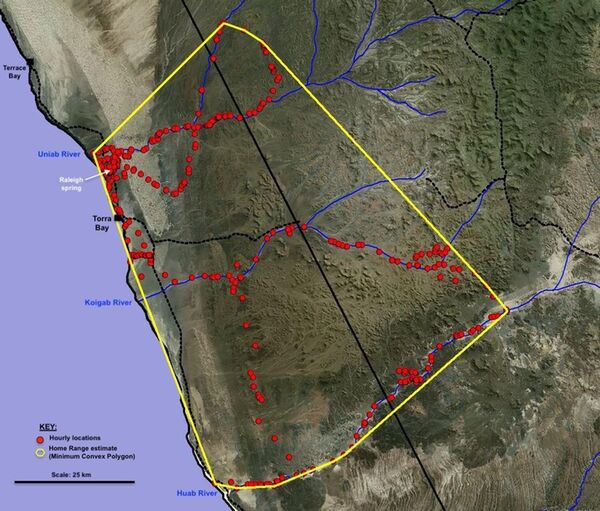
Figure 2.
Movement patterns of the lioness Xpl-108 and estimated home range size (MCP) of 5,905 km2 over a 70-day period.
During this period the lioness killed or scavenged a total of 30 prey animals, with the vast majority of her food consisting of Cape fur seals (Table 1). These food items consisted of a total estimate of 425 kg edible biomass (calculated by the average mass of the prey minus the inedible proportions). On average during the period the lioness acquired a per capita food intake of 6.1 kg per day. This compares favourably with general food requirements for lions that varies between 5 kg and 8.5 kg per lioness per day-1.
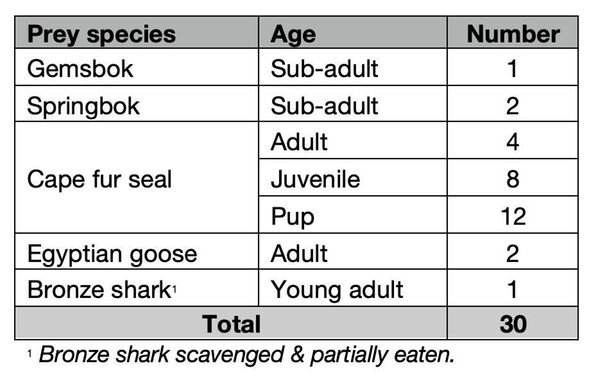
Table 1.
Total number of prey animals captured or scavenged over the two-month period.
In total the lioness spent marginally more time in the coastal and beach habitats compared to the riverbeds, gravel plains and mountains of the inland habitat (Figure 3). The movement patterns and her use of the three main habitat types, however, varied substantially over the two months when the data were separated into seven consecutive ten-day periods (Figure 4).
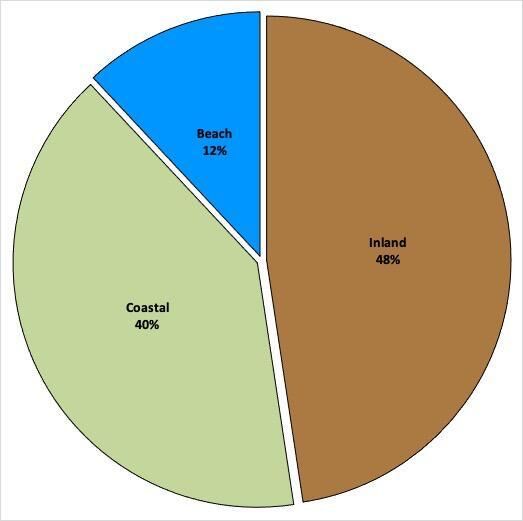
Figure 3.
Proportion of time spent in three habitat types by lioness Xpl-108 over a 70-day period (N = 1680).
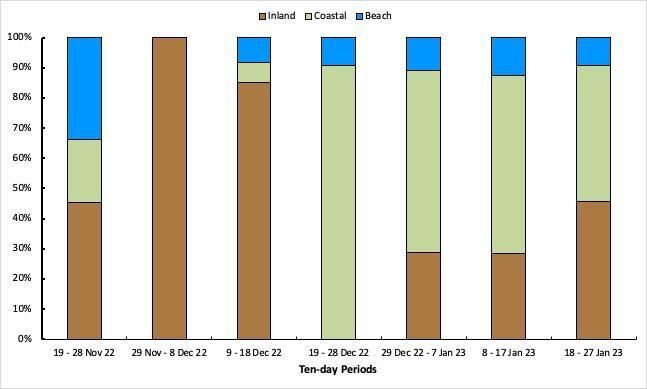
Figure 4.
Proportion of time spent in three habitat types during seven consecutive ten-day periods by lioness Xpl-108 over two months (N = 1680).
The entire coastal habitat, which includes the dunes and the beaches, was significantly more productive for the lioness during the two-month period (Table 2). During her inland visits the lioness walked longer distances and did not meet the minimum required food intake of 5 kg per day. The regular visits to the coast and the availability of Cape fur seals enabled the lioness to increased her food intake to 6.1 kg day-1.
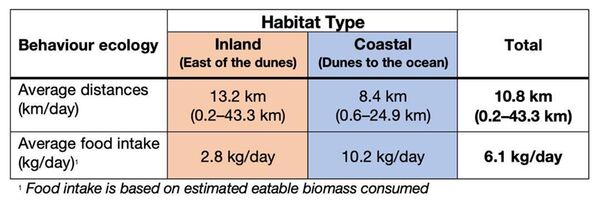
Table 2.
Comparison between the distances traveled and per capita food intake acquired by the lions Xpl-108 over two months.
The importance of the coast and the marine food items are illustrated further when comparing energy expenditure, such as kilometres travelled per day, and food intake over the consecutive ten-day periods (Figure 5). During the third ten-day section (9-18 Dec 22) the lioness wad 300 km at an average of 12.9 km/day without finding any food. Her return to the coast for the following 20 days resulted in higher levels of food intake and substantially less energy expenditure. A similar pattern of high energy output was evident during her third trip inland with an increase in food intake when she return to the coastal habitat at the end of January 2023.
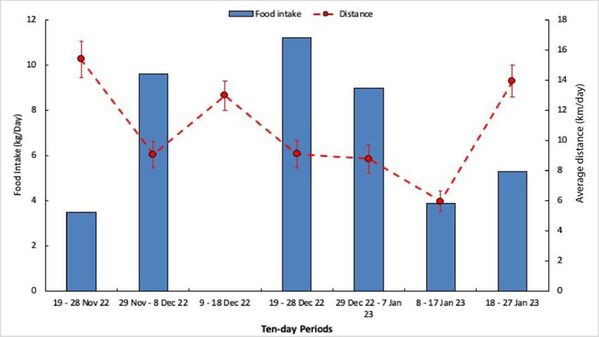
Figure 5.
Daily food intake and average daily distances walked by lioness Xpl-108 during seven consecutive ten-day periods over two months (N = 893).
Interactions with tourists and anglers at Torra Bay
When the lioness was inside the Torra Bay angling area her activities were monitored for 24 hours per day. At night, when lions are most active, Xpl-108 was observed with night-vision and infrared equipment. During the daylight hours the lioness generally rested amongst vegetation or between hummocks. In an effort not to attract the attention of visitors, the research vehicle would be parked on a high vantage point approximately 800 metres to 1 km away from the lioness. During these periods surveillance cameras with powerful lenses or a spotting scope were used to monitor the lioness and the movements of visitors.
During the peak visitor period (20 Dec 2022 - 10 Jan 23), especially when the lioness was resting at Raleigh spring, between 68 and 193 vehicles drove past the spring along the main C34 road. Peak hours were in the morning (08h00 - 11h00) and the late afternoon (16h00 - 18h00) when between 14 and 32 vehicles were counted. The majority of vehicles (65%) simply drove past the spring without taking notice, whereas 15% slowed down or stopped briefly. A surprisingly large number of vehicles (20%) stopped, scanned the area and waited for an opportunity to view the lioness (Figure 6). It was pleasing to observe that none of the passengers of the vehicles that showed interest in the lion got out of their vehicles. On the few evasions that the lioness was visible from the main road, a total of eight vehicles spotted the lioness and observed her for up to two hours, whilst 34 vehicles drove past without looking.
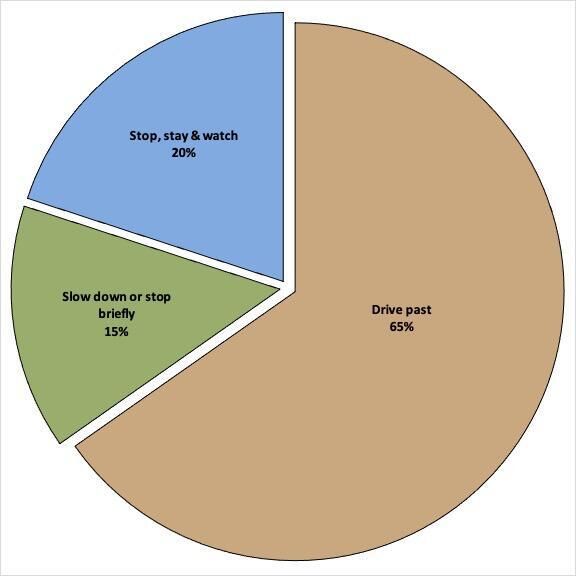
Figure 6.
Summary of the behaviour of visitors driving past Raleigh spring when the lioness Xpl-108 was resting in the reeds (N = 195).
During the 34 days that the lioness spent inside the Torra Bay fishing area, she moved onto beach at night on 18 occasions, only to return to Raleigh spring or other vegetation cover before daylight. When Xpl-108 first arrived at the coast, after the opening of Torra Bay, on 18 Dec 2022 she rested on a high lookout point where she observed all the vehicles and anglers moving up and down the coastline during the day. That night she approached the beach with caution and after killing a large adult Cape fur seal during the early morning hours, she made an extraordinary effort to drag the carcass 4.1 km inland. Across a large salt pan and to the top of a high granite hill. There she lay for three days eating and watching the vehicle and people activities on the beaches. Showing remarkable awareness and adaptation to the new dynamics in her usual hunting grounds, the lioness changed her behaviour and refrained from spending any time on the beaches during the daytime. During the ten-day period prior to the opening of Torra Bay, the lioness spent double the amount of time on the beach (see Figure 4 & photo).
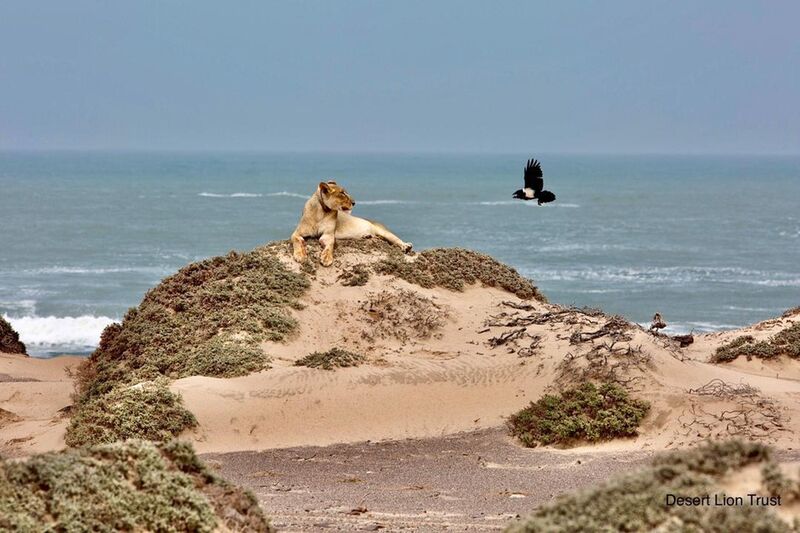
Xpl-108 resting on a hummock before the start of the Torra Bay Holiday period.
The vast majority of tourists were understanding and respectful of the presence of the lion in the area and many people want to see one of the uniquely desert-adapted Skeleton Coast lions. On 14 occasions visitors attempted to drive off-road to either approach the lion or the research vehicle. A strong strobing flashlight was used to attract their attention and hand signals used to ask vehicle not to approach. The method was successful and people respected the requests.There were only two high-risk incidents and both involved the lioness approaching anglers that were still active and out of the vehicles after sunset. The flashing strobe light was again effective in alerting the tourist and preventing further escalation. The last event on 27 Jan 2023, mentioned above, only resulted in disturbance to the lioness and possibly ruined her chance to catch an adult gemsbok.
A schematic illustration of a tourist vehicle spoiling the opportunity for lioness Xpl-108 to capture a gemsbok.
Communications, social media and information dissemination
The success of the monitoring exercise relied on there being reliable communication between the Research Vehicle and other involved parties, specifically DLCT personnel both on site near Torra Bay and in Swakopmund, as well as MEFT and NWR staff members at Torra Bay. It was also essential that the Research Vehicle and DLCT personnel could at any stage retrieve the latest GPS position of XPL108.
As such, the Research Vehicle and DLCT support vehicles were equipped with “Rover Units”. These units communicate via satellite with a centralised server in Swakopmund, which then forwards messages received from the unit to requested recipients. The messages are forwarded either via SMS to a cell phone, or via satellite to another Rover unit. The unit can also be used to request from the central server the latest GPS position of any lion fitted with a satellite collar. (The units are the same as used by the Rapid Response Teams in managing Human Wildlife Conflict in North Western Namibia).
Daily updates on the activities of the lions, accompanied by photos, videos and a map of her movements, were prepared from the research vehicle. Every second or third day this information was copied onto a memory flash-drive, packaged, and sent to Swakopmund via NWR and visitors. In Swakopmund the information was edited and sent to the Netherlands where it was prepared for several social media platforms.
